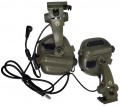Noise Reduction Ratio (NRR)
An indicator of how much volume in decibels tactical headphones cut during operation. Acoustic efficiency NRR (Noise Reduction Rating) is the sound absorption characteristics according to the requirements of the American quality standard. A similar standard in the European style is called SRR (about it, see above).
NRR is an assessment of how effectively a hearing protection device can reduce ambient noise levels. If headphones are marked with the “NRR 30 dB” mark, then they can reduce the level of external sounds by 30 dB. The higher the NRR value, the more effective the tactical headphones are at protecting the hearing aid.
Noise level limit
The maximum permissible sound pressure level that can reach the user's ears. Noise limits are necessary to protect the hearing aid from excessively loud sounds (gunshots, explosions, etc.). The limiting function is automatically activated when the sound pressure reaches a set limit to reduce or block the signal before being transmitted directly to the user's ears. Blocking loud sounds is achieved either by built-in electronics or by closing sound-conducting channels - the specific implementation of the function depends on the model of active tactical headphones.
Reaction time
Headphone response time to changes in the sound environment. This parameter refers to the interval between the time the noise level exceeds a safe hearing level and the response of the headphones when the external sound is reduced to a safe level. Fast reaction time is important to ensure an immediate protective response to external threats (shots, explosions, etc.).
Headset (microphone)
The presence of a microphone in the design of tactical headphones actually turns them into
a headset and allows them to be used for voice communication - for example, to confirm received commands over a walkie-talkie, talk on a paired mobile phone, etc. Also, built-in microphones often allow fighters to communicate with each other without the need to use radios and other external means.
Water protection
Tactical headphones are protected from dust and moisture. This paragraph also clarifies the level of such protection in accordance with the IP standard.
The degree of protection is usually denoted by two numbers according to the IP standard. The first number corresponds to dust protection. As a rule, tactical headphones indicate their maximum ratings of “5” and “6” (dust resistance without complete closure and complete dust resistance, respectively). The second digit indicates the degree of protection against water. For moisture-resistant models
with splash protection, markings up to the number “6” are used. Full
water resistance corresponds to levels 7 (possibility of immersion under water to a depth of 1 m for half an hour) or 8 (possibility of prolonged operation under water at a depth of more than 1 m). Thus, the maximum degree of protection according to this standard is IP68, completely sealed. There are also IPX8 markings, where the first digit is not indicated - this means that the headphones have not undergone official certification for dust resistance. However, water resistance level 8 automatically entails a sealed case that is also impenetrable to dust.
Helmet compatibility
This paragraph specifies the method of using headphones in conjunction with a tactical helmet or helmet (if such a possibility is provided in principle). Thus, many models can be worn
under a helmet - under-helmet earcups usually have a more compact design, a flat headband and a low profile to fit comfortably under tactical head gear. Models of the helmet-mount type are fixed
to the helmet using special guides for the rails of the OPS-CORE FAST, TOR-D, etc. systems.
Control
- Buttons. Controlling the operation of tactical headphones using classic mechanical buttons, which are often freely located on one of the ear cups. The buttons should be easy to find and press when wearing gloves. In general, they are responsible for the functions of adjusting volume, turning headphones on/off, selecting operating modes, adjusting the intensity of noise reduction, etc.
— Analog regulator. The analogue regulator provides convenience in using the functions of tactical headphones: the control of the wheel is intuitive, and such a regulator can be found and scrolled by touch without much difficulty. One wheel can be tasked with adjusting the volume level, turning the headphones on and off.
Operating time
Operating time of the headphones on one set of replaceable batteries or a full charge of the built-in battery (see “Power source”).
Using this parameter, you can roughly estimate the duration of use of tactical headphones without the need to replace batteries or recharge the power source. It is also intended to compare the real capabilities of different models.
Auto switch-off
Automatic shutdown is intended to save battery power or the built-in battery of tactical headphones. The
auto-shutdown feature may be based on failure to detect sounds or activity through built-in sensors or detection algorithms. In another implementation, the headphones automatically turn off after a set time of inactivity, and you can return them “to life” by pressing any button or turning the analogue control (see “Control”).

